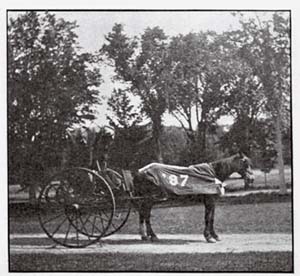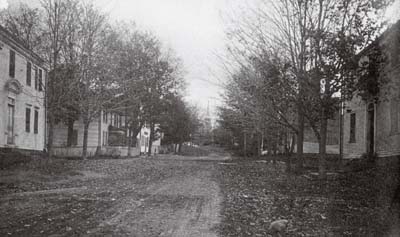 |
 |
| current issue |  |
past issues |  |
send a letter/news |  |
address update |  |
advertise |  |
about us |  |
alumni home |
Features
Cents and SensibilityPage 2 of 4
In 1841, the Boston & Maine Railroad came to Durham, and the Boston to Portland stage line ceased running. The coming of the railroad represented just one of a series of profound changes. The national shift from an agrarian to industrial economy had begun, as well as a migration from stony New England to the rich farmlands of the Midwest. In Durham, the town center even moved west slightly, to its present location, toward the railroad and away from the river, which would become less and less important.
Thompson sold a right of way to the B&M Railroad through his farm, running through the location of DeMerritt Hall and up what is now Edgewood Road. This was the first time he would make money from the railroad, but not the last.

|
True to his utilitarian and frugal values, Thompson worked hard at farming, but he also worked smart. He was the first to grow the Baldwin apple in Durham, budding and grafting his own trees, and was considered a pioneer in raising fruit for the Boston market. His farm produced hay, lumber, butter, cheese, vinegar, cider, meat, and grain. He seemed to record every penny in his account books, noting the price of a bushel of potatoes (25 cents), as well as the reason for a worker's absence ("wife sick" or "day fishing"). He provided his hired hands with meals, tobacco, rum and clothing. He watched over the operations with a keen eye, shouting "get every bit!" if he spied a worker trying to pass over a bee-infested forkful of hay.
After his father died in 1838, Thompson lived with his mother for two years and then announced he was taking a trip to Cuba. His mother moved in with her daughter and son-in-law, but "Uncle Ben," Mary Pickering Thompson later wrote, "never went to Cuba after all. It was only one of his sudden freaks that he never carried out." He moved back into the family home by himself and hired a housekeeper. A few years later, Lucetta Mary Davis, on vacation from her job in New York City's Astor Place, agreed to fill in for the housekeeper for two weeks. She ended up stayed for more than 40 years, acting as Thompson's housekeeper, nurse and confidential secretary until he died, in 1890, in the same house where he had been born.
When Thompson was 44, he learned that the object of his youthful desires, Sophia Haven Appleton, now the mother of three, had recently been widowed. A romance was rekindled, an engagement secured, and then Thompson gave his fiancée $1,000—more than $22,000 in today's dollars—to buy new furnishings for his house, located at the corner of Madbury Road and Main Street.

|
What happened next is a matter of some conjecture, since historical accounts differ. Niece Mary later wrote simply: "He jilted her without assigning any reason." In another version, Thompson affronts his betrothed by moving all her fancy Boston-bought furniture into the barn. In a 1932 book called New Hampshire Folk Tales, he comes home to find a fashionably flimsy chair, flies into a rage, and kicks it across the room, shouting, "[That's] the most hideous impractical, uncomfortable looking pile of sticks I ever saw hitched together!"
Also a matter of conjecture is whether the broken engagement had anything to do with something that happened six years later. That's when Thompson wrote his will, a document that not only gave the last 34 years of his life a higher purpose but also gave the state of New Hampshire a gift, a command and a blueprint. He had decided to bequeath virtually his entire estate to the state for the purpose of establishing an agricultural college, provided the college was located on his farm in Durham. In the original will and subsequent codicils, he stipulated what might be taught at the college and made other "suggestions," including the idea that students be required to say prayers and "labor on the land" every day.
Thompson also urged the state of New Hampshire to apply to Congress for a grant of land to help support the college. Given that the will was written in 1856—one year before Rep. Justin Morrill of Vermont proposed the land-grant act and six years before it was signed by Abraham Lincoln—Thompson's bequest seems rather bold and visionary. The act made each state eligible to receive public lands to be sold for the purpose of funding a state college devoted to teaching agriculture and mechanical arts. Ironically, the money from these sales could be used for just about anything except purchasing land. Thus Thompson was one of the first in a wave of farmers to donate the land for a land-grant college to sit upon.
Up until this point, both public and private colleges in the United States had largely followed the European tradition of educating upper-class young men for the clergy or the professions. In the mid-1800s there was a growing national movement to incorporate science into the curriculum and open access to "the industrial classes." Even spiritual leaders like Boston's most prominent minister, William Ellery Channing, preached the gospel of agricultural education. Thompson clearly had been following the national debate, reading political tracts in his armchair, and forming his own opinions.
Page: < Prev 1 2 3 4 Next >Easy to print version

